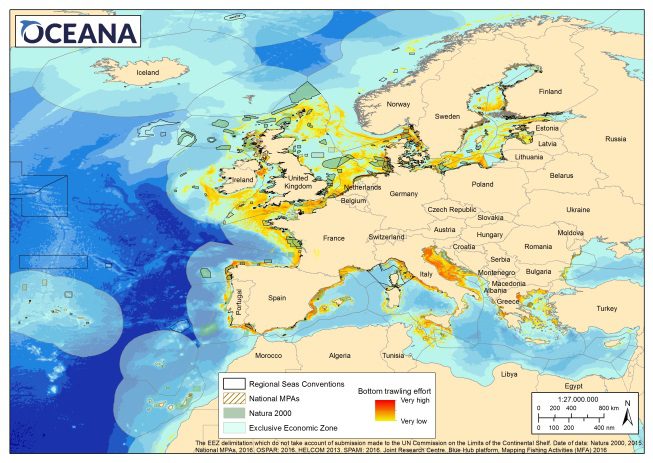Dozens of threatened species at risk due to flawed EU network of marine protected areas
Press Release Date: June 30, 2017
Location: Brussels
Contact:
Anna Baxter | email: abaxter@oceana.org
Anna Baxter
Oceana’s analysis conducted on 16 EU Member States’ plans for measures, has revealed a widespread lack of ambition to effectively use networks of MPAs to contribute to the EU’s objective of achieving healthy, clean and productive seas by 2020, as required under the Marine Strategy Framework Directive (MSFD). The current EU network of MPAs is severely flawed, as protection of deep-sea ecosystems is scarce and there is no fisheries management in many of the sites. The network of marine protected areas is far from reaching the target to protect 10% of marine and coastal ecosystems by 2020, at the latest.
The majority of EU countries do not intend to address these gaps when implementing the directive. Regulation of the fishing activities inside their MPAs is something particularly disappointing, especially from large maritime nations like France, Italy and Spain.
“We can catch almost 60% more fish in European waters in less than 10 years, but only if we protect important habitats. It is, therefore, a great disappointment to learn that fisheries restrictions in MPAs are mostly left out from the list of protective measures. It is also unacceptable that member states have no intention to protect dozens of other threatened communities protected by international conventions of new MPAs, including many fishes, sharks and rays, whales and crustaceans,” said Lasse Gustavsson, Executive Director of Oceana in Europe.
Two-thirds of European MPAs are designated to protect just eighteen marine species and five habitats through the EU Natura 2000 network. Oceana’s survey found that these threatened species are ignored by EU Member States in their MSFD Program of Measures for MPAs.
Oceana urges the European Commission to ensure that EU Member States implement adequate MSFD measures contributing to the establishment of an ecologically coherent and well-managed network of MPAs. The following steps should particularly be taken into account to effectively halt the loss of marine biodiversity in Europe:
- Creation of no-take zones within existing MPAs;
- Protection of Essential Fish Habitats (E.g. seasonal or real-time closures);
- Restrictions of commercial and recreational fisheries inside MPAs;
- Active restoration measures in degraded parts of MPAs (e.g. artificial reefs).
|
Map of European bottom fishing pressure in relation to the European MPA network |
Summary assessment or MPA designation measures according to national MSFD Programme of Measures |
|
|
|
|
Key facts:
|
|
Note to the editor:
Under the Marine Strategy Framework Directive (2008/56/EC), national Programmes of Measures (PoMs) are expected to identify and implement required measures to achieve Good Environmental Status by 2020. For Marine Protected Areas, PoMs should address the ecological gaps and the development of effective management plans, which should theoretically include not only commercial fisheries but all relevant human activities such as dredging, shipping, recreational activities, agriculture or aquaculture.
Report: Programmes of Measures under the Marine Strategy Framework Directive





